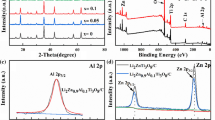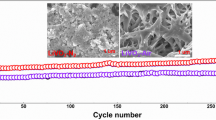Abstract
A series of Li1−xNaxV3O8 (0<x<1) solid solution were investigated as positive materials for secondary lithium batteries. The materials were characterized by X-ray diffraction and infrared spectrum measurements, showing that pure phases of Li1−xNaxV3O8 were formed with the same monoclinic structure as LiV3O8. The electrochemical characteristics including charge–discharge characteristics were compared with those of LiV3O8 and NaV3O8, showing that the Li0.7Na0.3V3O8 electrode shows the best electrochemical performance among several Li1−xNaxV3O8; at a current density of 0.2mAcm−2, it gave a discharge capacity of 215mAhg−1-oxide which was about 80% of the theoretical discharge capacity. The cathode current loading test also showed that Li1−xNaxV3O8 has the advantage of both LiV3O8 and NaV3O8. Furthermore, the thermodynamics and kinetics of lithium intercalation into the oxide structure were also examined.
Similar content being viewed by others
References
N. Kumagai and K. Tanno, Denki Kagaku 48 (1980) 432.
G. Pistoia, M. Pasquali, G. Wang and L. Li, J. Electrochem. Soc. 137 (1990) 2365.
J. O. Besenhard and R. Schollhorn, J. Power Sources 1 (1976/77) 267.
K. West, B. Zachau-Christiansen, M. J. L. Qstergard and T. Jacobsen, ibid. 20 (1987) 165.
K. Takei, N. Tarada, K. Ishihara, T. Iwahori and T. Tanaka, Ext. Abstr., The Electrochemical Soc.,91-2(44) (1991).
M. Pasquali and G. Pistoia, Electrochimi Acta 36 (1991) 1549.
G. Pistoia, G. Wang and D. Zane, Solid State Ionics 76 (1995) 285.
P. Novak, W. Scheifele, F. Joho and O. Haas, J. Electrochem. Soc. 142 (1995) 2544.
G. Wang and G. Pistoia, J. Electroanal. Chem. 302 (1991) 275.
N. Kumagai, S. Tanifuji, T. Fujiwaraand K. Tanno, Electrochim. Acta 37 (1992) 1039.
Y. Kera, J. Solid State Chem. 51 (1984) 205.
K. M. Abraham and M. Alamgier, J. Electrochem. Soc. 137(1990) 1657.
A. D. Wadsley, Acta Cryst. 10 (1957) 261.
G. Pistoia, M. Pasquali and M. Tocci, J. Electrochem. Soc. 132 (1985) 281.
L. A. de Piccitto, K.T. Adendor., D. C. Liles and M. M. Thackeray, Solid State Ionics 62 (1993) 297.
C. Ho, I. D. Raistric and R. A. Huggins, J. Electrochem. Soc. 127 (1980) 269.
W. Weppner, R.A. Huggins, Ann. Rev. Mat. Sci. 8 (1978) 269.
Author information
Authors and Affiliations
Rights and permissions
About this article
Cite this article
Kumagai, N., Yu, A. & West, K. Li1−xNaxV3O8 as positive materials for secondary lithium batteries. Journal of Applied Electrochemistry 27, 953–958 (1997). https://doi.org/10.1023/A:1018457820021
Issue Date:
DOI: https://doi.org/10.1023/A:1018457820021




